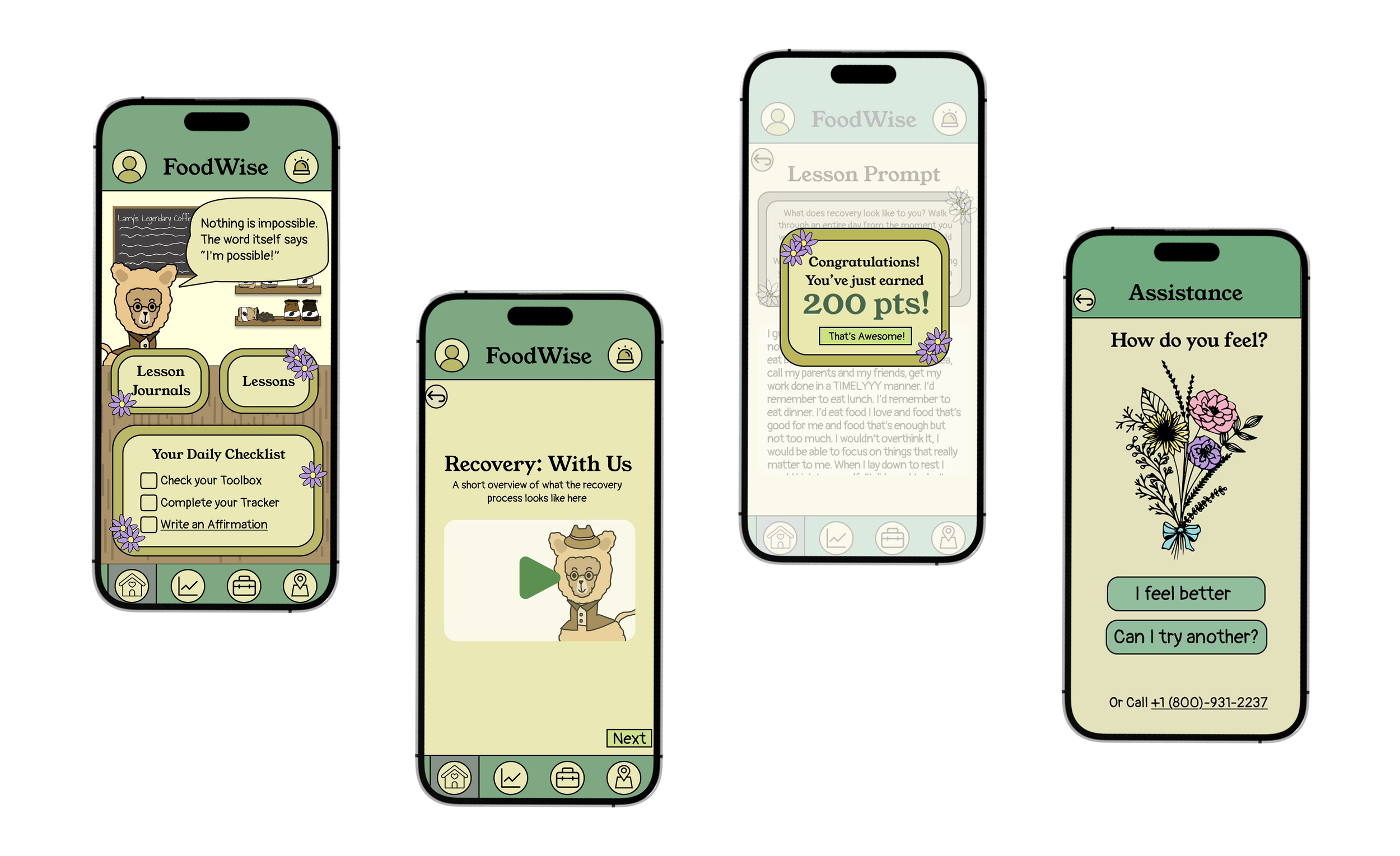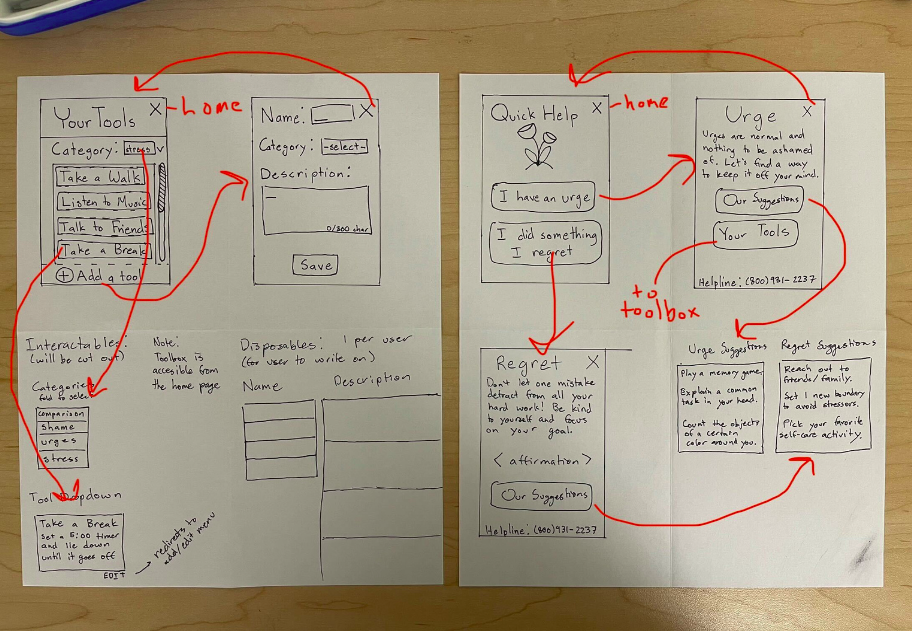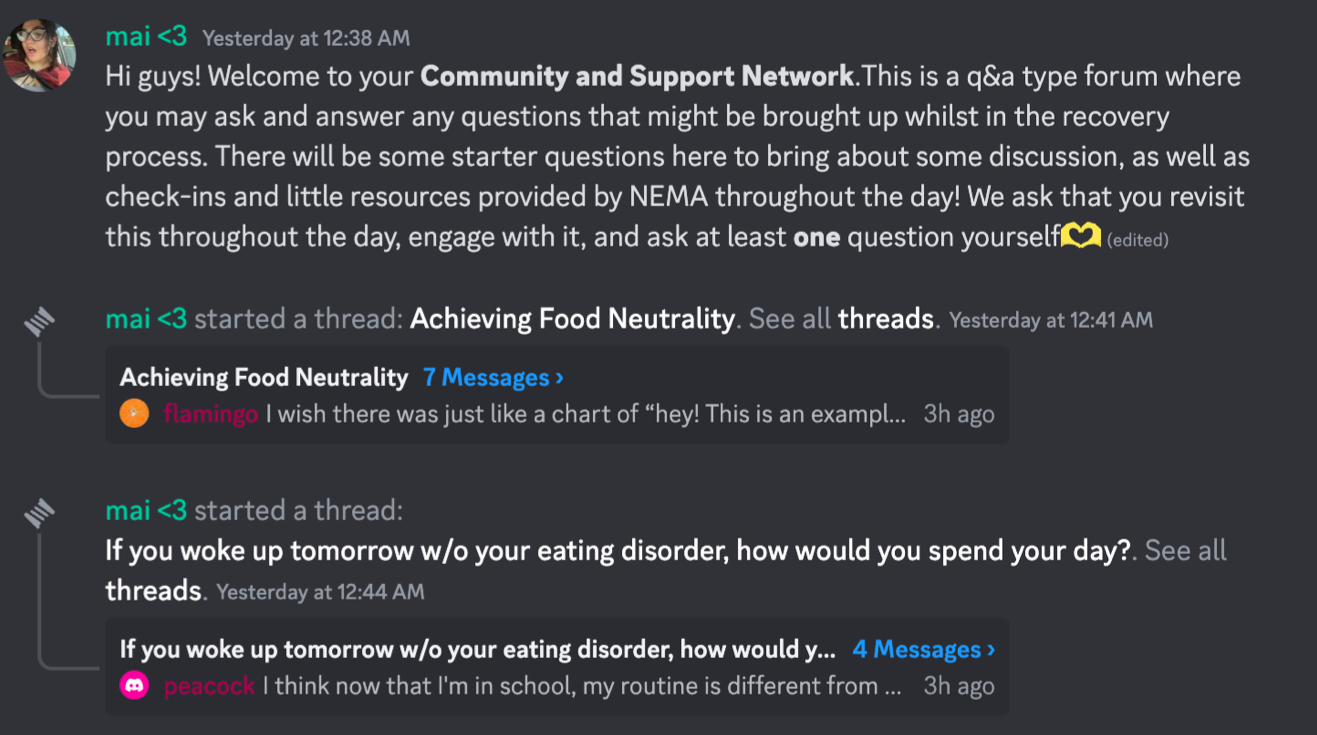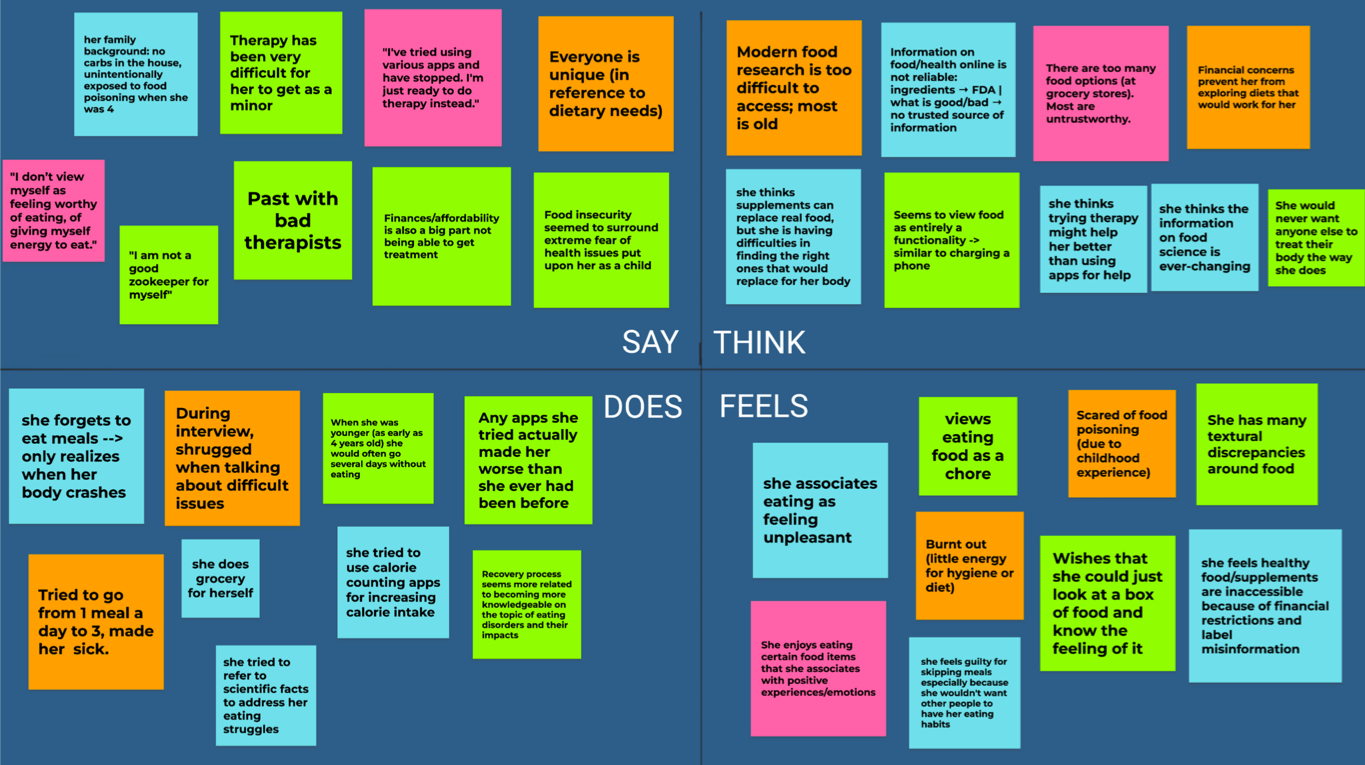Your Roadmap to Real Recovery
Sep 2024 - Dec 2024
CS 147: Introduction to Human-Computer Interaction Design
During CS 147, my team and I worked on a 10 week-long project to create a user-centered solution with the goal of providing a technological intervention for mental health. That solution is FoodWise — Your Roadmap to Real Recovery.
FoodWise is an application designed to help users whilst they are in eating disorder recovery through a personalized recovery roadmap. With a stress and mood tracker, fully customizable toolbox catalog of go-to coping skills, and an emergency help feature for times of relapse, the app equips the users with knowledge and skills for true and sustainable healing.
FoodWise was honored at the Stanford Design Thinking for User Experience Project Expo at the end of the course, receiving 1st for Best Concept and 2nd for Best Overall Project (out of 120+ students and 30+ teams).
Tools: Figma, ReactNative, Expo, Node, Git
Roles: UX Researcher, UI/UX Designer, Frontend Developer
Team: Ava Love, Elton Manchester, Mai Mostafa, NaYoung Son
Our Design Process
Our Problem Space
The FoodWise problem space centers on how we can use technology to support and educate individuals in eating disorder recovery—helping them rebuild self-trust, mindfulness, and healthy eating patterns through empathetic, educational, and reflective digital design, rather than surveillance or self-punishment.
2. Needfinding
We conducted five in-depth interviews with individuals who had experienced disordered eating to understand their motivations, setbacks, and recovery processes. Each interview was conducted with care and ethical sensitivity, ensuring comfort and consent.
Empathy Maps From Our First Three Interviews
3. Synthesis, POVs, & Experience Prototyping
We translated our findings into three primary POVs (Points of View) representing different user archetypes each with unique challenges in recovery.
POV 1 (JH)
We met JH a college senior from Korea, who has a history of bulimia brought about by pressures of female beauty standards. We were surprised to realize she puts extreme pressure on herself to lose weight and, as a result, has an all-or-nothing mentality when it comes to food restrictions. When breaking food rules, she feels guilt that causes her to fall into a cycle of binging and purging. We wondered if this means her eating disorder behaves like an addiction in that it is largely triggered by common life stress and acts as an obsession with a body standard. It would be game-changing to provide healthy interventions that prevent triggering a relapse into the addiction of an eating disorder.
HMW
break the cyclical nature of disordered eating and relapse?
POV 2 (JH)
We met JH a college senior from Korea, who has a history of bulimia brought about by pressures of female beauty standards. We were surprised to realize even though she struggled with comparing herself to others, her eating habits improved when she had company. We wondered if this means the presence/company (in-person or virtual) of trusted friends/community can help prevent her falling back into eating disorder habits (binging and purging). It would be game-changing to Improve access to others who are also on a road to recovery to act as a reliable support system in her recovery.
HMW
use positive messaging and accurate information to shift users’ mindsets in recovery?
Moderate: Toolbox
Add triggers with associated coping mechanisms
Our poster served as a visual synthesis of the entire design journey. We organized it around three key threads:
The Problem Space — highlighting the inaccessibility of eating-disorder therapy and the emotional challenges of self-guided recovery.
Our Solution — the stage-based roadmap, toolbox, and tracker system.
Our Process — a clear progression from needfinding → low-fidelity → medium-fidelity → high-fidelity prototyping
To balance sensitivity and engagement, we used soft pastel colors and hand-drawn mascots (the turtle and llama) to symbolize progress and companionship.
Our Key Insights
Stress and overwork commonly triggered disordered eating cycles.
Misinformation online worsened both relapse and recovery attempts.
Therapy is expensive and inaccessible.
Self-motivation fluctuates, making it hard to sustain progress.
Emotional regulation and coping were critical to recovery.
“All-or-nothing” thinking created guilt and relapse loops.
Body image issues remained persistent even after behavioral recovery.
Key Takeaway: Simple notifications are not sufficient to change habits. It is worth noting that some interviewees did forget to eat, and the notifications did not help prevent this.
Info + Trivia prototype: tested whether food education could shift mindsets.
POV 3 (JL)
We met JL, a college junior from Philadelphia, who has a history of anorexia and, more recently, developed bulimia. At her lowest, she was eating around 300 calories per day and walking around 12 miles per day. We were surprised to realize despite viewing her eating disorder as morally incorrect, when asked for what she believes is her healed, happy self, she identified a target weight (that she compared to someone in her sorority). We wondered if this means she finds self-worth in how skinny she is and focuses on where she feels she doesn’t meet beauty standards. Hence, her comparison to others is a driving force of her eating disorder. It would be game-changing to shift her motivation for recovery to focus on health rather than weight/body image.
From these, we generated over 30 How-Might-We (HMW) statements, then prioritized three:
Key Takeaway: The prototype failed to adequately test the assumption, but provided important feedback. Information is most helpful when tailored to the user’s specific misconceptions, which was not exactly accomplished in this case.
Community Prototype: tested the emotional benefits of peer support.
Key Takeaway: The test was not a resounding success but still supports the assumption. However, we weren’t able to test during times of stress, so the emotional regulation aspect is not confirmed. Worth further consideration!
4. Concept Development & Market Research
Using insights from prototypes, we refined our solution: A stage-based recovery roadmap combining structured guidance, self-reflection, and positive reinforcement.
We felt this best suited our problem space! While community presents a good opportunity, it is also difficult to regulate and ensure others are not encouraging each other negatively rather than positively. We found in the trivia that while the information is useful, it should be structured towards users specific needs, and we felt the best way to convey this was based on the “stage” of recovery they are on. Our stages are borrowed from the addiction recovery models G-CHIME and ETM, inspired by the insights JH gave us in her needfinding interview.
We then studied four leading apps — Noom, Pomellow, Recovery Record, and Brighter Bite — to identify gaps:
From this our concept evolved into a holistic recovery companion, combining:
Educational modules with bite-sized lessons and reflective journaling
A Toolbox for coping mechanisms
A Mood and stress tracker, to see clear progress over time
A gamified roadmap guiding users through the stages of recovery
With our new refined concept, we identified four core design values to guide us throughout our process
Structure allows people to see a tangible solution to their problem
Autonomy empowers the user to regain control of their habits
Growth is necessary to instill hope. When you see progress, you believe it
Fun is vital to ensure the user continues their recovery
HMW
involve community to support recovery and accountability?
To test early assumptions and possible features of the app, we conducted experience prototypes on Discord:
Notification Prototype: tested reminders for eating habits.
5. Lo-Fi Prototyping & Testing
We constructed paper prototypes representing 3 taskflows:
Simple: Toolbox
Add triggers with associated coping mechanisms
Moderate: First Stage
Complete onboarding, set daily personal goals, progress forward by achieving goals and checking in with the “shop owner”
Complex: The First Level
After onboarding, explore the app, set daily “mini goals”, do a lesson and a reflection activity, log your mood and stress
You can read more about our Medium-Fidelity prototype in our README
8. High-Fi Prototyping & Heuristic Evaluation
Using React Native and Expo Go, we developed a functional cross-platform prototype with consistent branding and navigation. We then ran a cross-class heuristic evaluation.
Our most pressing violations were:
Consistency & Standards (H4)
Inconsistent button designs
Some text boxes looked like buttons
Aesthetic & Minimalist Design (H8)
Some pages were visually overwhelming and distracting
Help & Documentation (H10)
Lacks clear instruction in the beginning about how to navigate and unlock levels
Our revisions included:
Simplifying the onboarding survey
Many users indicated that although it was thorough, it was a long and tiresome onboarding process which could easily be shortened.
Consistent styling for buttons and headers
Buttons were consistently styled with green background and black outline, headers had background color removed
Clear tutorials and help (?) buttons on all screens
You can read more about our High-Fidelity prototype in our README
9. Poster, Pitch, & Demo
As we finalized our high-fidelity prototype, our focus shifted toward communicating our design story — turning months of research and iteration into a concise, compelling narrative for the CS 147 Design Expo.
This phase was as much about storytelling as design: we wanted every artifact — the poster, pitch, and live demo — to reflect FoodWise’s empathetic tone and structured recovery philosophy.
Pitch Presentation
We wanted our pitch to evoke empathy and hope, reflecting both the seriousness of eating disorders and the optimism of recovery.
Our final 30-second script read:
“Eating disorder recovery is hard, and therapy is often costly and stressful.
Introducing FoodWise — your go-to companion for your recovery journey.
Through a personalized roadmap, FoodWise equips you with the habits and skills for sustainable healing.
You are not alone. Take the first step toward a new life with FoodWise today.”
Delivered live alongside our final slide (below), this pitch succinctly communicated the heart of FoodWise — an empathetic, educational, and empowering tool for self-guided recovery.
This single slide brought together our visual identity:
Warm, inclusive illustration showing emotional support and safety.
Interface mockups highlighting the roadmap and toolbox features.
Color palette of soft greens and peaches symbolizing calm, renewal, and growth.
Tagline: “Your roadmap to real recovery.”
Together, these elements reinforced FoodWise’s dual goals — to make recovery feel structured yet gentle, clinical yet human.
Live Demo
Our live demo was built with React Native + Expo Go, allowing visitors to interact with the prototype directly on their phones.
The demo flow guided users through:
Introductory survey → personal reflection and onboarding
Toolbox feature → adding, editing, and deleting coping tools
Lesson module → completing an educational task with journaling
Mood Tracking → for mood, stress, and “food noise”
Emergency Assistance → help for instances of relapse/near-relapse
We also prepared Wizard-of-Oz interactions for non-functional components (e.g., the tracker’s pre-filled data and lesson video mockups) to preserve flow and realism during testing.
During the Expo, we presented FoodWise to instructors, peers, and visiting judges.
Feedback praised the clarity of our value proposition and the harmony between empathetic tone, gamified visuals, and educational content. Visitors described the experience as “uplifting,” “non-judgmental,” and “surprisingly joyful for such a serious topic.”
Complex: Maintenance
Maintaining recovery through a personal garden once you’ve completed the roadmap
We then conducted usability tests with four participants who were familiar with disordered eating. We found that:
Users appreciated the friendly visuals and conversational tone, finding it motivating.
Some interactions (e.g., layered popups) were confusing.
Surveys risked being too long or invalidating for certain disorders.
Users wanted earlier access to personalization and recovery tracking.
The complex task actually had the fewest clicks, which suggests it is actually simpler, it was intended for experienced users, but could see use by typical users
8. Med-Fi Prototyping
We took our insights and transitioned to digital, building an interactive Figma prototype. We shifted our taskflows and expanded our app structure to include five roadmap stages:
Awareness → Understanding → Emotional Regulation → Self-Compassion → Maintenance.
Each represented by a unique shop with a unique shop owner.
Simple: The Introductory Survey
Designed to collect intake information that can inform the lesson modules shared with the user for their particular recovery journey.
Poster Design
Our Design Process is also fully documented on our website! There you can find our reflections from user interviews, prototyping and testing solution ideas, our final low, medium, and high fidelity prototypes, and our final report.
https://hci.stanford.edu/courses/cs147/2024/au/projects/Technology-for-Mental-Health/FoodWise/
Our Concept Video
*won two awards during our in-class concept video expo! Best Location and Most Consistent Values
Our Final Solution
Our Final Project Demo
Implementation
Our final prototype was developed in React Native and deployed through Expo Go, enabling seamless testing across iOS and Android devices. The full implementation is open-source on GitHub.
We translated our Figma designs directly into code, carrying over the same soft palette, typography, and warmth that defined the app’s visual identity. Each page—the Toolbox, Roadmap, Tracker, and Emergency Assistance—was built as its own interactive environment, guiding users through the same structured yet compassionate journey we envisioned in our storyboards.
To simulate the feeling of a complete, living product, we used Wizard-of-Oz elements like pre-filled tracker data and placeholder lesson videos, allowing participants to experience the rhythm of recovery FoodWise encourages: reflection, learning, and growth through gentle guidance.
Reflection
CS 147 was my first time really delving into human-computer interaction design, and I couldn’t be more grateful for that. This is hands down one of, if not the best, class I’ve taken at Stanford.
From start to finish over 10 weeks, the course guides you through every aspect of creating an app. It is through this course that I learned how to conduct my first user interview, how to identify pain points, how to create a comprehensive solution, how to make and test prototype. It was my first time genuinely learning how to engineer a solution.
I look back on this course and project with the utmost pride and fondness. At a time when I was unsure of what I wanted, FoodWise came and showed me that I am capable. That not only do I have the passion for design, but the ability for it as well. Although my imposter syndrome is certainly not cured (whose is), this project gave me the first real chance to show what I can accomplish. Not only to others, but to myself.
FoodWise won Best Concept and 2nd Best Overall at the Design Thinking for User Experience Project Expo at the end of the course. If I were to expand on this project, I would love to develop the methodology behind the recovery process we created more. With more substantial research, I sincerely believe this could help many, many people. I would love to see it through one day.


























